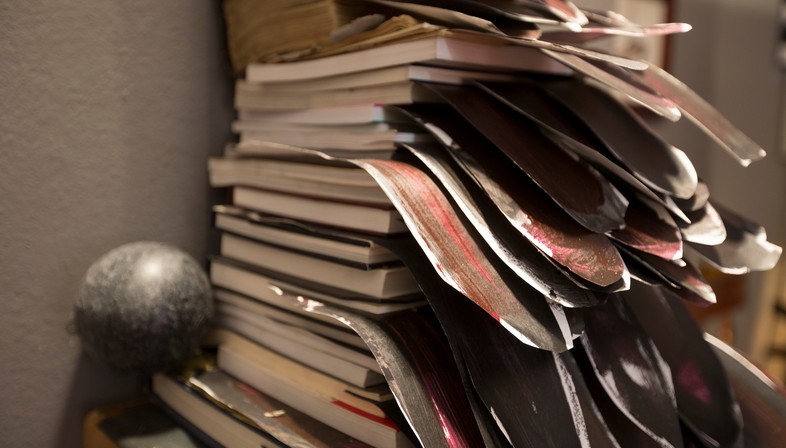
安东尼奥·马拉斯(Antonio Marras)将自己定义为自命不凡的人,寻求事物,是废物产品的复兴者。A tinkerer, a rag-and-bone man, with a dash of poet thrown in. ‘Then, of course, I also make these rags of mine,’ he added, almost as if to justify the work for which he is so widely renowned. He guides me through the various spaces of his Milan workshop, illustrating in detail the many installations set up for Design Week. Marras pauses thoughtfully to explore materials and objects; he does not speak of meanings, nor does he associate lofty ideas or concepts with his pieces. He simply describes the creative process and tells me where he procured the materials. These installations have a strikingly dramatic presence: their sheer evocative power is enchanting, echoing with the memories and stories with which they are imbued. They are art in its purest form, living a life without words, without commentary. There are two constants here: first, the reclamation of everyday objects - or rather, pieces of them: drawers, books, frames, chairs, tiles and scraps of ceramics, headboards, mirrors, suitcases, worn-out frames, painted canvases, stained pages of old books, used footballs - and second, the colour palette: ivory, black, brown, burgundy in its richest, densest shade that has become his signature shade.
From unearthing discarded objects to composing them into a piece, the entire process is a work of art: there is a tower of suitcases entitled ‘Scale sconvolte’ [‘Disrupted Stairs’], with an accordion at the base and a small model boat placed on top; there is ‘Teresa, Jana portiera’ [‘Teresa, Jana the Goalkeeper’], an old disassembled loom, found in a tiny village in Sardinia, in which Marras has hung five footballs covered in fabric (once the playthings of his children when they were young); there is ‘Malelingue’ [‘Slanderers’/‘Evil Tongues’], a totem pole of sorts made up of a tall stack of old books with paper and fabric tongues sprouting from between their pages, with a white first aid kit at the very top. But the collection continues: there are also paintings turned the wrong way around, their backs adorned with old pages of the Gazzetta Ufficiale or a small papier-mâché leg or arm - perhaps belonging to a cherub or angel - salvaged from a craftsman in Lecce who was about to throw them away. Unsettling presences redolent of votive offerings.
然后是一系列陶瓷:花瓶,篮子,松锥,各种瓷砖。毫无疑问,陶瓷是Marras的首选材料:“它使我可以用手塑造东西。触摸是一种基本的感觉。触摸是身体上的需求,是紧迫的要求。我记得小时候开着妈妈在墙上开着墙,因为我会触摸所有东西,当然,我经常会打破一些东西。对我来说,陶瓷就像一张空白的纸。我坐在陶器的轮子旁,我们一起制作花瓶”。Marras将线条雕刻在他的花瓶的白色釉中,从而散发出大胆的黑色层。他使用这种技术来勾勒出各种面孔,手,人物。双手在他的作品中无处不在:“我对手非常着迷 - 它们出现在我的绘画中,也出现在我的陶瓷中”。 A whole row of ceramic creations hangs on his wall, each with an arm joined together with string, just like the paper dolls we would all cut out as children.
And as the designer-cum-artist tells his story, his hands perpetually dart around as if to accompany the accents, almost moulding his very words: “For me, creating ceramics has become a moment of non-thought: when I’m crafting it, all the cares that gnaw away at me every day simply fall away,” he adds. In a corner stand the majestic totem poles created for the Museum of Ceramics in Mondovì, made up of a stack of vases crowned with figures of deformed roosters. “I take these animal shapes in my hands when the clay is still soft,” says Marras, “and then I mould them, reinventing them with imaginative plasticity”.
The character in whom Marras has identified his path of regeneration is called Cerchino (roughly ‘Little Seeker’ or ‘Little Circle’), the opposite of Pollicino [‘Tom Thumb’]: whilst the latter sprinkles crumbs and pebbles as he wanders, Cerchino (the artist’s alias) picks up anything and everything he comes across to give objects a second chance at life. “Cerchino loved pieces of copper, rusty iron, metal of all kinds,” goes the fairytale that accompanies the exhibition. “He was crazy about ceramics, terracotta and porcelain. He loved used, old, dirty and stained sheets of paper, books, pages of writings and drawings and paintings by unknown artists which he could work on, insert himself into, add to and change, making them into something other than their original mission. Cerchino hated waste, indifference and misuse”. As I gaze at the circular tower made up of old drawers that takes centre stage in the showroom, surrounded by clothing, Marras’ way of thinking suddenly becomes clear to me: there is value inside everything, and our job is to seek it out, salvage it and restore it.
安东尼拉·加利
字幕和学分
所有图像均由安东尼奥·马拉斯(Antonio Marras)提供
01艺术家的肖像
02和14安东尼奥·马拉斯(Antonio Marras),马洛林[邪恶的舌头]
03-13发电后生成后期,安东尼奥·马拉斯(Antonio Marras)在米兰(Milan)的Cola di Rienzo 8的非稳定性空间中安装了Fuorisalone 2022。
15安东尼奥·马拉斯(Antonio Marras),塞奇诺(Cerchino)的肖像































